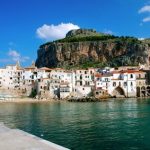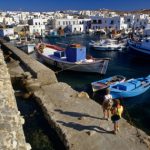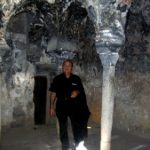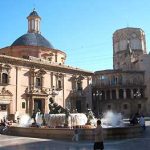 The Paris Motor Show last September bought a moment of joy to VW owners around the globe, the return of the beloved people’s sport car, the Volkswagen Scirocco, which hoped on sale by late 2007. But, for many north American VW enthusiasts, the origin came as a surprise, the VW AutoEuropa outside Setubal, Portugal. AutoEuropa currently builds the European market only the Sharan and Eos models.
The Paris Motor Show last September bought a moment of joy to VW owners around the globe, the return of the beloved people’s sport car, the Volkswagen Scirocco, which hoped on sale by late 2007. But, for many north American VW enthusiasts, the origin came as a surprise, the VW AutoEuropa outside Setubal, Portugal. AutoEuropa currently builds the European market only the Sharan and Eos models.
Beyond the new Scirocco, Setubal has a lot to be proud of a. It is birthplace of the famous Chelsea soccer coach Jos’ Mourinho, the devilish Portuguese poet Manuel Maria Barbosa du Bocage, and singer Luisa Todi. It is the birthplace to Portugal’s most famed style, Manueline, and was once the most respected producer of salt in Europe.
Okay, not a compelling reason to go there. But imagine this, ordering your new Scirocco, and picking it up at Autoeuropa. Then what?
Setubal, is located on the northern bank of the Sado river estuary, about 26 miles south of Portugal’s cool capital, Lisbon. A colony of dolphins now lives in the Sado R, making nature and the wild even closer.
On arrival in Setubal, one can’t help but notice the wealth of the city’s Roman remains. On the Travessa de Frei Gaspar ancient roman tanks for the fish processing industry were used throughout the 1st to 5th centuries to make a Roman favorite, garum. Yummy fish paste. Looming above the city is the Fortaleza de Seo Filipe (Fort of St. Philip), no longer hosting cannons but a modern Pousada hotel. The 16th century fort was constructed to defend the port from passing marauders and enjoys a privileged position at the mouth of the River Sado. Overlooking the scenic beaches of the Troia Peninsula, the mountains of Serra da Arribida act as its backdrop. It is the work of the Italian architect Filipe Terzio and was built at the orders of King Filipe II to protect the entrance to the Sado estuary.
Down below, in the Largo de Jesus, we find city’s most striking monument: the Convent and Church of Jesus (15th century). The Igreja de Jesus is a remarkable Gothic church with its interior columns carved in Arribida pink stone from the nearby quarry. The architect Diogo Boitac designed this wonderful early example of Manueline style in 1494.Peak inside the late 15th century church to discover that his is first building in the Portuguese late Gothic style known as Manueline. n architecture, Manueline style of Portuguese late Gothic. The church is a blend of this unique Portuguese style of architectural ornamentation incorporating maritime elements and discoveries. It evokes famed voyages of Vasco da Gama and Pedro Alvares Cabral. The Manueline style was named after King at the time, D, Manuel I (1495 to 1521). Turn up around lunchtime and succumb to the temptations of the grilled fish at the restaurants along the riverside. This will be the freshest taste of the sea one can imagine, as the city still boasts a good sized fishing fleet.
No surprise for the third largest port in Portugal – well sheltered from the Atlantic Ocean.
 The 16th Century Cathedral Santa Maria da Graia opens a window on beautiful azulejo tiles from the 18th Century. Museu de Setubal is to be found in the Mosterio de Jesus with a wealth of religious relics and paintings. Part of the collection is dedicated to the local son, 18th Century Portuguese romantic poet Bocage. The Museu de Arqueolagia e Etnogrofia has a varied and interesting collection of items discovered in the immediate region, from Bronze Age pots to the processing of cork. Setubal not long ago, like that legendary Scirocco nameplate had fallen on hard times, has risen again to a new golden era.
The 16th Century Cathedral Santa Maria da Graia opens a window on beautiful azulejo tiles from the 18th Century. Museu de Setubal is to be found in the Mosterio de Jesus with a wealth of religious relics and paintings. Part of the collection is dedicated to the local son, 18th Century Portuguese romantic poet Bocage. The Museu de Arqueolagia e Etnogrofia has a varied and interesting collection of items discovered in the immediate region, from Bronze Age pots to the processing of cork. Setubal not long ago, like that legendary Scirocco nameplate had fallen on hard times, has risen again to a new golden era.
A century ago, Setubal was an important center for Portugal’s fishing industry, sardines in particular. And, for those who many recall the canned Portuguese sardine, the reason they re so hard to find today is that all the factories are gone today. At the same time, the salt industry, and the pink salt do Setubal was once acclaimed ad the best in eh word, dried up, too. With its industrial and fishing life is in decline, tourism became the big opportunity for the future. And with the white cliffs of the coast of Arribida natural park nearby the city has access to some of the most beautiful beaches in Europe.
Just south of and across the river from Setubal on the sandy peninsula of Traia, time has reversed. Numerous ugly high-rise luxury resorts have been demolished, and the entire area is being redeveloped.
Nearby to the west and south of Setubal is the Reserva Natural do Estuario do Sado, a nature reserve park of vast stretches of mud flats, lagoons and small forests of pine trees. To the west of the town is the quaint Portinho da Arribida, a large cove type beach facing south and protected from the north winds by a high slope. Climb half way up this slope set in the deserted natural greenery is a solitary 16th Century Franciscan Monastery enjoying what must be one of the most beautifully restful views in Europe. This Monastery has been restored by the Fundao Oriente and is being now used as a Study Center. Close to the beach there is a small 17th Century Fort that houses a small Sea and Marine Biology Centre. Rising up from the seashore, Arribida Park is a striking coastal landscape just outside Lisbon. Its highest point is at Serra do Risco, a magnificent 380 meter high cliff.
Guided walks or mountain biking are just two of the ways of exploring this natural environment, a rare national example of a unsullied Mediterranean landscape and vegetation. Options even extend to night tours.
Take the “Circuito das Serras” a jeep tour for the swiftest way of getting to the Park’s highest points, or try the “Circuito dos Arrozais” a tour, taking in part of the Sado River estuary.
Continue towards Palmela. There, the Maria I fountain points the way to the Castle built on an abutment jutting out from the Serra da Arribida, and now home to an attractive Pousada-manor hotel. Donated by Afonso Henriques to the Military Order of Santiago de Espada, and recently restored. The view from its walls is truly magnificent. Inside, there is the tiled Convent and Church of Santiago.
To the south on the old road to the Algarve is the town of Alcacer do Sal that was once the capital of the now extinct province of Al-Cassr until it was regained in the 12th Century from the Moors by the Christian forces. The castle and the Convento de Santo Antonio was built in the 16th Century but was destroyed in 1755 by an earthquake. The castle has been restored into a comfortable Pousada for the overnight visitors to the region. Immediately to the north of Setubal is the proud town of Palmela with its castle high walls sitting on the crown of its hill. In the 12th Century, Dom Afonso Henrigues gave this town to the Order of Santiago for their headquarters. The Igreja do Convento de Sant’Iago, which was originally built in the 15th Century has suffered considerably from the destruction of the 1755 earthquake but has been recently restored with a part being made into a Pousada. From its high location the view from the walls stretch back to Lisbon and far into the Alentejo. To the northwest is the small village of Azeitio. Here are the Quinta do Bacalhau and the Quinta das Torres, both from the 16th Century and both full of charm and history. The first is famous for its wine and the second for its hospitality as a country Inn. Notably in the same area are the famous Wine Cellars of Jose Maria de Fonseca.The seat of the municipality is the city of As of 2005, a new luxury resort is planned to replace today’s Traia. You can view Traia at Albarquel, a beach located in the very beginning of Arribida.
Reaching Portinho da Arribida, take a wander along the beach, located between the highest point of Serra da Arribida and the sea. The Pedra da Anixa, a small rocky island just off the sand is a choice spot for underwater spear fishing. Restaurants along the beach specialize in fish caldeirada (a stew-like dish) and the famous Setubal red mullet.
The beautiful landscapes of the Serra da Setubal and the beaches around the Sado river estuary provide an excellent backdrop to this scenic tour to the south of Lisbon.
Do not get confused, there are two “Azeitio”. Start in Vila Nogueira de Setubal. At the foot of the Serra da Arribida (a Natural Park), this town is home to a rich historic and artistic heritage, particularly from the 16th and 18th centuries, including the renaissance Dukes of Aveiro Palace, the Church of S. Lourento (St. Laurence) and the baroque Pasmados fountain. In this village try some of the justly famous and delicious cheeses and visit one of the local producers to find out how they are made.
Then continue to Vila Fresca de Azeitio. In the town surrounded by large country estates, the church of Sao Simao (St Simon) features a fine 16th century example of Nossa Senhora da Saude (Our Lady of Health). In the Quinta das Torres, there is now a country hotel (and an excellent choice for somewhere to spend the night) located in the 16th century mansion with the gardens being of particular beauty.
At tea time taste the divine tortas de Azeitio, accompanied by the local nectar, a beautiful chilled fruity muscatel wine, tasting as sweet as love itself.
A visit should also be paid to admire the sophisticated heritage of Quinta da Bacalhoa (. Its Palacio (Palace of Bacalhoa Farm) dates from the final quarter of the 15th century and is one of the finest examples of renaissance architecture in Portugal.
Take a walk in the hills, underwater snorkeling, sea fishing or try the produce of these waters and a fresh grilled fish or some shellfish.
You can also put on a pair of sturdy walking boots, pack your lunch, and discover some of the hidden corners of these hills that swoop right down to the Atlantic. Enjoy the striking landscapes as you walk the paths. Discover the Capuchin monastery in the middle of the forest. In Setubal marina, take a trip on a traditional salt galleon out onto the Sado estuary or along the Arribida coastline.
At the Sado Estuary Nature Reserve see some dolphins. I In the river that could be seen from the Setubal castle, is possible to see some friendly dolphins swimming around, oblivious to everything else around them, having chosen the fabulous deep blue swimming-pool of the Sado Estuary as the setting for their own jumping and diving competitions.





Leave a Reply